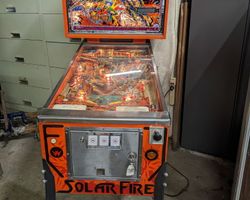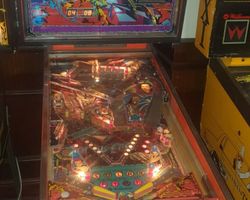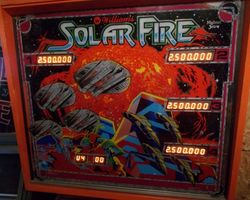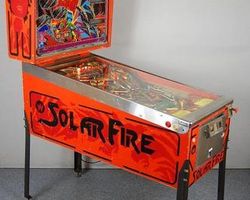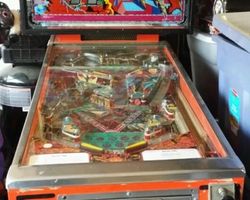Solar Fire
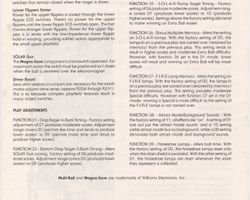
Average Prices: USD $400 to $2,900
Produced: July, 1981
Production Run: 782 units
Machine Type: Solid State Electronic
MPU: Williams System 7
Players: 4
Design by: Barry Oursler
Art by: Constantino Mitchell, Jeanine Mitchell
Sound by: Ed Suchocki
Software by: Ed Suchocki
"Solar Fire," a captivating solid-state electronic pinball machine released in July 1981 by Williams Electronic Games, Inc., emerged as a bold statement during a period of rapid innovation in the industry. With a production run limited to just 782 units, it quickly became a sought-after collectible, embodying the dynamic creativity that defined the early 1980s pinball landscape. Its theme, a vibrant foray into the cosmic unknown, plunged players into a sci-fi universe brimming with alien encounters and interstellar challenges.
The machine's genesis involved a dedicated team of Williams talent. Barry Oursler, known for his ability to craft engaging play experiences, served as the designer. His vision for a challenging and rewarding game was brought to life visually by Constantino Mitchell and Jeanine Mitchell, whose artistic collaboration defined the machine's distinctive aesthetic. Ed Suchocki was responsible for the intricate software and unique sound design, weaving together the auditory and interactive elements that characterize the Williams System 7 platform. A curious detail on the playfield, near the upper right flipper, reveals a hidden message artfully disguised within the light shield: "JEANINE LOVES CONSTANTINO" and "CONNIE LOVES STINKER," a personal touch from artist Connie Mitchell, referencing his daughter Lauren.
Signature Features and Design
"Solar Fire" stands out with a collection of features that set it apart. Central to its allure is the two-level playfield, a design choice that immediately adds verticality and complexity to the game flow. This multi-tiered approach allows for a deeper, more strategic engagement with the machine's various objectives. The game is equipped with four flippers, providing ample control and shot opportunities across both playfield levels.
A defining characteristic is the innovative Magna-Save, an electromagnet mechanism positioned on the lower playfield. This feature provides a last-ditch effort to save a draining ball, requiring precise timing and strategy to activate. Unlike some other implementations of such mechanisms, "Solar Fire"'s Magna-Save could be recharged by hitting specific drop target sets, intertwining its use with the broader game objectives. Another distinctive element is the "Solar Gun," a captive ball located on the playfield that is repeatedly propelled across a scoring switch by a pulsed electromagnet. This creates a timed scoring opportunity, adding a dynamic layer of urgency and excitement.
The artwork by Constantino and Jeanine Mitchell embraces a vivid, space-fantasy aesthetic. The cabinet is notably presented in a striking orange hue, immediately drawing attention. The playfield art is a busy yet cohesive depiction of an alien world, featuring otherworldly creatures and cosmic backdrops. This visual style, while sometimes described as unusual, perfectly encapsulates the sci-fi theme and complements the machine's energetic gameplay. The strategic placement of numerous drop targets across the playfield further enhances the visual and tactile experience, with their distinct clatter and immediate feedback on successful shots.
Playfield and Mechanics
The "Solar Fire" playfield is a meticulously designed arena for skill and precision, engineered around its split-level architecture. The lower playfield serves as the primary battleground, featuring a central cluster of targets and pathways leading to the upper deck. Notable elements on this level include three banks of 3-bank drop targets and one 4-bank drop target, totaling thirteen drop targets that demand accurate shooting to clear. Each bank cleared contributes to objectives and can recharge the Magna-Save, creating a constant interplay between defense and offense. Three kick-out holes are strategically placed, often returning the ball to the flippers or launching it into a new scoring sequence.
Ascending to the upper playfield is achieved via two pathways, which lead to a more condensed area packed with additional targets and the crucial ball locks for multiball. The design philosophy behind "Solar Fire"'s layout emphasizes direct, controlled shots over random ball movement. The absence of pop bumpers, a common feature in many pinball machines, significantly shifts the emphasis to flipper control and shot accuracy. This design choice fosters a more skill-based game, where successful play stems from precise aiming and understanding ball trajectories.
The playfield's artwork contributes significantly to player immersion. The vibrant blues, purples, and greens, set against the orange cabinet, evoke the vastness of space and the mystique of alien encounters. The lighting system, while characteristic of its era, highlights key targets and pathways, guiding the player's eye towards active objectives. The overall aesthetic, while sometimes considered polarizing, is undeniably part of "Solar Fire"'s identity, solidifying its place as a visually distinct machine of the early 1980s.
Gameplay Dynamics
"Solar Fire" delivers a fast-paced and challenging gameplay experience centered on precision and strategy. The ruleset, while not overly convoluted, offers rewarding progression for skilled players. A primary objective is to light the three separate ball locks to initiate multiball, a chaotic and high-scoring mode that tests a player's ability to manage multiple balls simultaneously across the two playfield levels.
Timed scoring elements are crucial to high scores. Activating the "Solar Gun" feature, for example, transforms a captive ball into a rapid-fire scoring opportunity, requiring players to capitalize on its timed duration. The banks of drop targets are not merely points opportunities; clearing them often advances game modes, lights special scoring, or, critically, recharges the Magna-Save. The risk-versus-reward aspect is palpable; attempting a challenging shot to clear a target bank might leave the ball vulnerable, yet the payoff of recharging a save or advancing a mode can be substantial.
Players often develop strategies around clearing the drop targets efficiently to maintain Magna-Save availability, making the challenging shots to the upper playfield for ball locks, and mastering the timing of the Magna-Save itself. The game's often punishing nature, where missed shots can lead to quick drains, cultivates a strong "one more game" mentality, compelling players to refine their technique and conquer its demands.
Reception and Legacy
"Solar Fire" garnered a largely positive reception within the pinball community, frequently cited as an engaging and addictive "player's game." Its strengths are often highlighted by its well-designed rules and challenging shot geometry, which reward precision and skill. The two-level playfield is consistently praised for adding depth and strategic variety, distinguishing it from single-level contemporaries. Features like the Magna-Save and the unique Solar Gun are often commended for their innovative design and contribution to the game's distinct character. Many players appreciate the absence of pop bumpers, believing it reduces randomness and elevates the importance of direct flipper control. Its relative rarity, with only 782 units produced, also contributes to its desirability among collectors.
However, "Solar Fire" is not without its critiques. Some players find its sound effects, while classic Williams System 7, to be repetitive, particularly the persistent drop target timer sound. The machine's high difficulty is a double-edged sword; while it appeals to those seeking a challenge, it can be punishing for less experienced players, leading to shorter game times. A few opinions suggest the Solar Gun, while unique, does not fully utilize its playfield real estate. The artwork, while vibrant and thematic, receives varied feedback; some consider it striking, while others find it somewhat chaotic or "muddy." Comparisons to the popular Williams "Black Knight" are common, with some feeling "Solar Fire" lacks enough unique elements to truly stand out, while others view it as an evolution, often described as "Black Knight on steroids." The Magna-Save's unpredictability, though part of its challenge, can also be a source of frustration when it flings the ball unexpectedly.
Despite any criticisms, "Solar Fire" holds a significant place in pinball history. It is recognized as a standout example of Williams' System 7 era, showcasing Barry Oursler's design prowess and the innovative use of features like the multi-level playfield and Magna-Save. Its focus on skill-based play and rewarding yet demanding objectives solidified its reputation as a machine that genuinely tests a player's abilities. Its rarity and enduring appeal ensure its legacy as a desirable and highly regarded title among enthusiasts and collectors, influencing future designs with its emphasis on strategic depth and unique interactive elements.
Sponsored Links
 Ebay Listings
Ebay Listings
 Auction Results
Auction Results
| Cost | Location | Date |
|---|---|---|
| USD $3,200 |  Ohio, United States Ohio, United States |
31 May, 2025 |
| USD $1,700 |  Oklahoma, United States Oklahoma, United States |
01 December, 2024 |
| USD $3,000 |  Wisconsin, United States Wisconsin, United States |
09 September, 2024 |
| USD $2,400 |  Tennessee, United States Tennessee, United States |
05 May, 2024 |
| USD $1,800 |  Virginia, United States Virginia, United States |
16 February, 2023 |
| USD $1,150 |  Illinois, United States Illinois, United States |
30 January, 2023 |
| GBP £3,200 |  Nuneaton, United Kingdom Nuneaton, United Kingdom |
14 October, 2022 |
| USD $3,500 |  Nevada, United States Nevada, United States |
02 September, 2022 |
| USD $4,444 |  Florida, United States Florida, United States |
26 July, 2022 |
| USD $5,600 |  Maryland, United States Maryland, United States |
12 November, 2021 |


Private Policy · Search Website · Contact Us
As an eBay Partner, we may earn a commission from qualifying purchases made through links on this site, at no additional cost to you.
All trademarks and copyrighted materials remain property of their respective owners. All other content copyright 2007 - 2025 Pinpedia.

